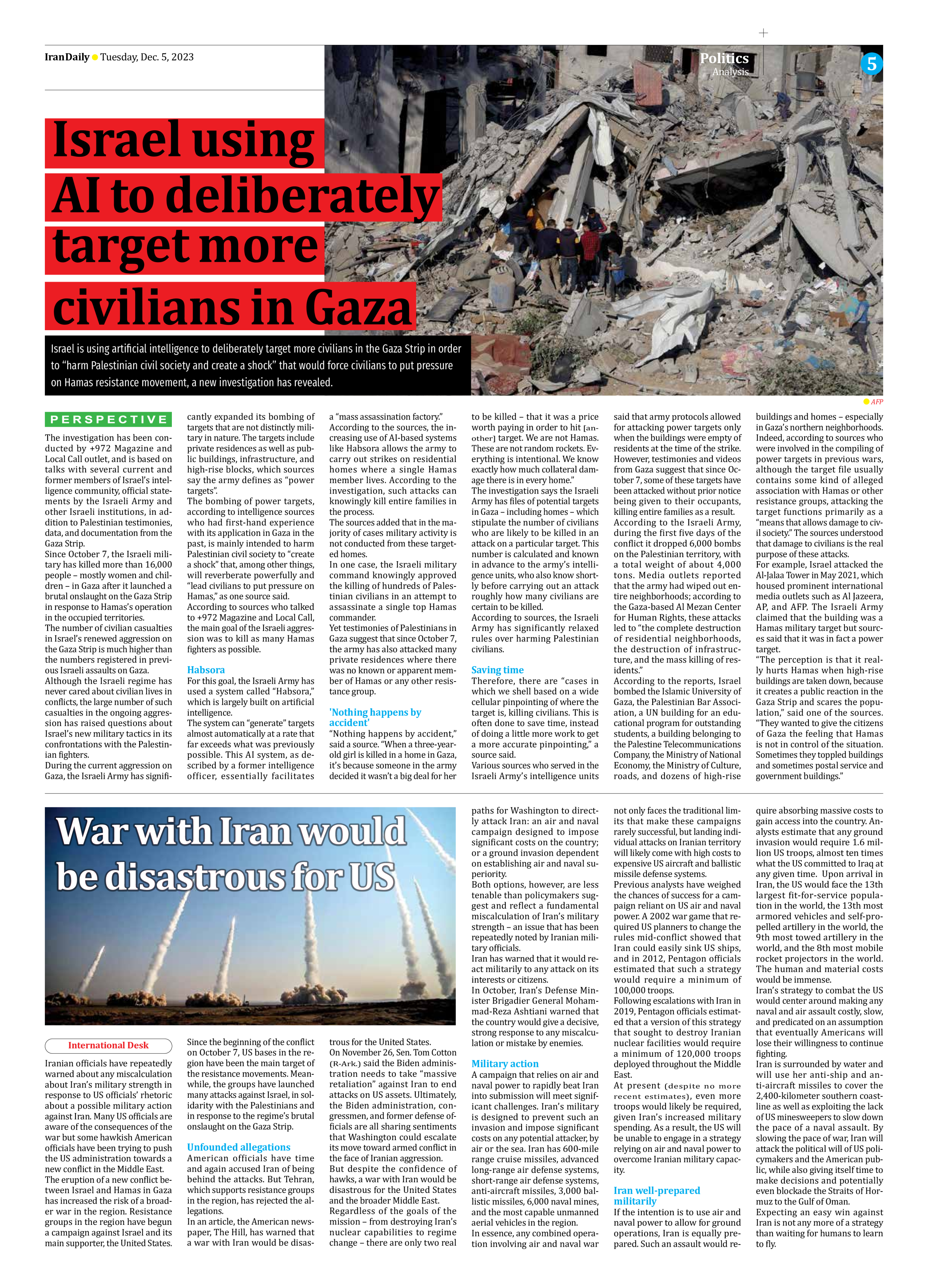
War with Iran would be disastrous for US
Iranian officials have repeatedly warned about any miscalculation about Iran’s military strength in response to US officials’ rhetoric about a possible military action against Iran. Many US officials are aware of the consequences of the war but some hawkish American officials have been trying to push the US administration towards a new conflict in the Middle East.
The eruption of a new conflict between Israel and Hamas in Gaza has increased the risk of a broader war in the region. Resistance groups in the region have begun a campaign against Israel and its main supporter, the United States.
Since the beginning of the conflict on October 7, US bases in the region have been the main target of the resistance movements. Meanwhile, the groups have launched many attacks against Israel, in solidarity with the Palestinians and in response to the regime’s brutal onslaught on the Gaza Strip.
Unfounded allegations
American officials have time and again accused Iran of being behind the attacks. But Tehran, which supports resistance groups in the region, has rejected the allegations.
In an article, the American newspaper, The Hill, has warned that a war with Iran would be disastrous for the United States.
On November 26, Sen. Tom Cotton (R-Ark.) said the Biden administration needs to take “massive retaliation” against Iran to end attacks on US assets. Ultimately, the Biden administration, congressmen, and former defense officials are all sharing sentiments that Washington could escalate its move toward armed conflict in the face of Iranian aggression.
But despite the confidence of hawks, a war with Iran would be disastrous for the United States and the broader Middle East.
Regardless of the goals of the mission – from destroying Iran’s nuclear capabilities to regime change – there are only two real paths for Washington to directly attack Iran: an air and naval campaign designed to impose significant costs on the country; or a ground invasion dependent on establishing air and naval superiority.
Both options, however, are less tenable than policymakers suggest and reflect a fundamental miscalculation of Iran’s military strength – an issue that has been repeatedly noted by Iranian military officials.
Iran has warned that it would react militarily to any attack on its interests or citizens.
In October, Iran’s Defense Minister Brigadier General Mohammad-Reza Ashtiani warned that the country would give a decisive, strong response to any miscalculation or mistake by enemies.
Military action
A campaign that relies on air and naval power to rapidly beat Iran into submission will meet significant challenges. Iran’s military is designed to prevent such an invasion and impose significant costs on any potential attacker, by air or the sea. Iran has 600-mile range cruise missiles, advanced long-range air defense systems, short-range air defense systems, anti-aircraft missiles, 3,000 ballistic missiles, 6,000 naval mines, and the most capable unmanned aerial vehicles in the region.
In essence, any combined operation involving air and naval war not only faces the traditional limits that make these campaigns rarely successful, but landing individual attacks on Iranian territory will likely come with high costs to expensive US aircraft and ballistic missile defense systems.
Previous analysts have weighed the chances of success for a campaign reliant on US air and naval power. A 2002 war game that required US planners to change the rules mid-conflict showed that Iran could easily sink US ships, and in 2012, Pentagon officials estimated that such a strategy would require a minimum of 100,000 troops.
Following escalations with Iran in 2019, Pentagon officials estimated that a version of this strategy that sought to destroy Iranian nuclear facilities would require a minimum of 120,000 troops deployed throughout the Middle East.
At present (despite no more recent estimates), even more troops would likely be required, given Iran’s increased military spending. As a result, the US will be unable to engage in a strategy relying on air and naval power to overcome Iranian military capacity.
Iran well-prepared
militarily
If the intention is to use air and naval power to allow for ground operations, Iran is equally prepared. Such an assault would require absorbing massive costs to gain access into the country. Analysts estimate that any ground invasion would require 1.6 million US troops, almost ten times what the US committed to Iraq at any given time. Upon arrival in Iran, the US would face the 13th largest fit-for-service population in the world, the 13th most armored vehicles and self-propelled artillery in the world, the 9th most towed artillery in the world, and the 8th most mobile rocket projectors in the world. The human and material costs would be immense.
Iran’s strategy to combat the US would center around making any naval and air assault costly, slow, and predicated on an assumption that eventually Americans will lose their willingness to continue fighting.
Iran is surrounded by water and will use her anti-ship and anti-aircraft missiles to cover the 2,400-kilometer southern coastline as well as exploiting the lack of US minesweepers to slow down the pace of a naval assault. By slowing the pace of war, Iran will attack the political will of US policymakers and the American public, while also giving itself time to make decisions and potentially even blockade the Straits of Hormuz to the Gulf of Oman.
Expecting an easy win against Iran is not any more of a strategy than waiting for humans to learn to fly.







